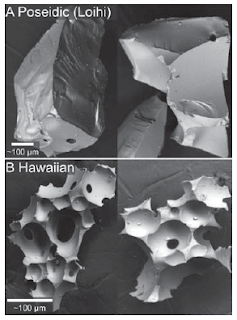This morning at 06:50 to 09:45 Santiaguito entered a volcanic eruption with 4 face of crater collapses and pyroclastic flows generated within the gullies on the southern flank. The ash column reached heights of 27,000 feet in a westerly direction, northwest and north, forcing the closure of village schools southwest of Santiaguito and in the Quetzaltenango area. A similar eruption to this has not been seen since 1989. The ash is still scattered at 24,000 feet and civil aeronautics alerted air traffic to avoid the plume within a radius of 80 km.
If you haven't seen my earlier posts on Santiaguito (my study area), here's a little background: The Santiaguito lava dome complex is a set of four lava domes at the base of the now inactive Santa Maria Volcano. Currently only one of the domes (El Caliente) is active, and this is the site of yesterday's eruption. Typically, activity on Caliente is limited to 1-3 km high ash-and-gas explosions every hour or two, accompanied by the extrusion of a blocky lava flow from Caliente's summit, occasional pyroclastic flows, and almost continuous rockfalls. Yesterday's event appears to have been quite a bit larger than the usual activity, and has disrupted life for the people living near the domes.
The last eruption at Caliente of this magnitude occurred in 1989, and produced similar ashfall and pyroclastic flows in the drainages on the south side of the domes. Before that, there was the 1973 event, a large collapse and pyroclastic flow from the Brujo lava dome (the last dome to the west of Caliente). Brujo is no longer erupting today, although there is some fumarolic (mostly water vapor) activity. (For more information on the 1973 event, have a look at this paper: Rose, W.I., 1973, Nuée ardente from Santiaguito volcano, April 1973: Bulletin of Volcanology, v. 37, p. 365-371.)
Dealing with ashfall isn't very fun, as folks in Europe can attest, since it gets into everything and makes breathing uncomfortable, if not difficult. On my last field excursion to Guatemala, we were lucky to be out of the way of the ash plume from Caliente - the prevailing winds kept it blowing in the opposite direction of our camp. I'm also quite glad that this event occurred after we were off the domes, because it might have meant dealing with major ashfall at the least, and possibly pyroclastic flows from the column collapse.
Here's some reporting from a few other news sources (this also repeats what was posted on the Volcanism Blog, but I wanted to note the articles that had photos):
El volcán Santiaguito hace declarar alerta naranja - El Periodico (in Spanish, with eruption photo)
Elevan a naranja la alerta en Guatemala por el volcán Santiaguito - EcoDiario (also in Spanish; it appears to have a photo of a large eruption, but I'm not sure if it's Santiaguito or just a stock photo)
Alerta Naranja por ceniza de volcán - El Quetzalteco (in Spanish, with a photo of the reduced visibility on the road leading to the north side of Santa Maria)
Declaran en Guatemala la alerta naranja por la erupción del volcán Santiaguito - Que Es (in Spanish, with a photo that appears to be of Pacaya rather than the domes at Santiaguito)
"Santiaguito Volcano showers sand and ash over Guatemala" - The Australian (via the Agence France-Presse)
My previous posts on Santiaguito and Santa Maria:
Santiagutio Volcano Observatory
Looking backward: Past eruptions at Volcán Santa Maria
Santiaguito lava dome complex
Lava domes, coffee, and a little bit of shaking
The last eruption at Caliente of this magnitude occurred in 1989, and produced similar ashfall and pyroclastic flows in the drainages on the south side of the domes. Before that, there was the 1973 event, a large collapse and pyroclastic flow from the Brujo lava dome (the last dome to the west of Caliente). Brujo is no longer erupting today, although there is some fumarolic (mostly water vapor) activity. (For more information on the 1973 event, have a look at this paper: Rose, W.I., 1973, Nuée ardente from Santiaguito volcano, April 1973: Bulletin of Volcanology, v. 37, p. 365-371.)
Dealing with ashfall isn't very fun, as folks in Europe can attest, since it gets into everything and makes breathing uncomfortable, if not difficult. On my last field excursion to Guatemala, we were lucky to be out of the way of the ash plume from Caliente - the prevailing winds kept it blowing in the opposite direction of our camp. I'm also quite glad that this event occurred after we were off the domes, because it might have meant dealing with major ashfall at the least, and possibly pyroclastic flows from the column collapse.
Here's some reporting from a few other news sources (this also repeats what was posted on the Volcanism Blog, but I wanted to note the articles that had photos):
El volcán Santiaguito hace declarar alerta naranja - El Periodico (in Spanish, with eruption photo)
Elevan a naranja la alerta en Guatemala por el volcán Santiaguito - EcoDiario (also in Spanish; it appears to have a photo of a large eruption, but I'm not sure if it's Santiaguito or just a stock photo)
Alerta Naranja por ceniza de volcán - El Quetzalteco (in Spanish, with a photo of the reduced visibility on the road leading to the north side of Santa Maria)
Declaran en Guatemala la alerta naranja por la erupción del volcán Santiaguito - Que Es (in Spanish, with a photo that appears to be of Pacaya rather than the domes at Santiaguito)
"Santiaguito Volcano showers sand and ash over Guatemala" - The Australian (via the Agence France-Presse)
My previous posts on Santiaguito and Santa Maria:
Santiagutio Volcano Observatory
Looking backward: Past eruptions at Volcán Santa Maria
Santiaguito lava dome complex
Lava domes, coffee, and a little bit of shaking























